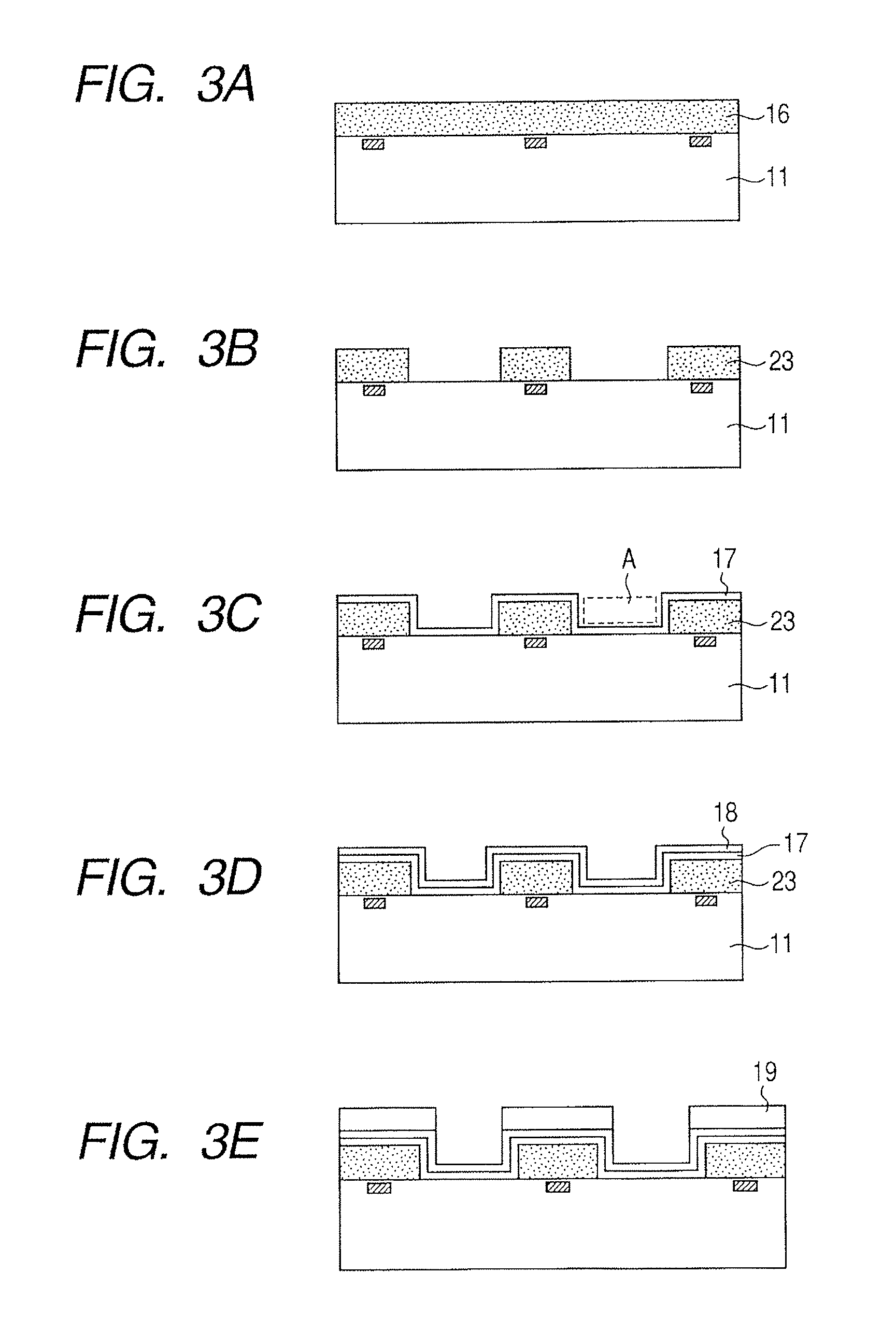Ink jet recording head and manufacturing method of ink jet recording head
a technology of ink jet and recording head, which is applied in the direction of printing, etc., can solve the problems of affecting the discharge of ink, affecting the dimensional accuracy of ink jet, and forming dent on the groove, so as to reduce the temperature rise of the recording head, reduce the wiring resistance, and increase the strength of the wall members of the liquid chamber.
- Summary
- Abstract
- Description
- Claims
- Application Information
AI Technical Summary
Benefits of technology
Problems solved by technology
Method used
Image
Examples
example 1
[0035]The process chart of FIGS. 3A, 3B, 3C, 3D, 3E, 3F, 3G, 3H, 3I and 3J is a schematic sectional view at the time of seeing the same surface as that of FIG. 1.
[0036]As shown in FIG. 3A, the substrate 11 on which heating resistors 18 as energy generating elements to generate energy to be used for discharging ink were formed was prepared. Next, Al 16 was formed on the substrate 11 to be about 15 μm in thickness by the sputtering method as a material to form the shapes of ink paths made of a removable material.
[0037]Next, as shown in FIG. 3B, resist was formed on the Al 16 by the photolithographic method, and the Al 16 was etched using the resist as a mask with phosphoric acid to form the shapes 23.
[0038]Next, as shown in FIG. 3C, a wall member 17 was formed to be 10 μm in thickness with silicon oxide by the CVD under the condition of about 400° C. using a mono-silane gas as a raw material. At this time, because the wall member 17 grew along the forms of the shapes 23, dent portions...
example 2
[0047]As for the present example, a description is given to an example forming surface protection films for protecting the surfaces in which the discharge ports are formed in addition to the structure of the example 1.
[0048]As shown in FIG. 3G, the manufacturing process was performed similarly to that of the example 1 until the step of flattening the surfaces of the shapes 23 and the metal layers 15.
[0049]A description is given to the steps after the flattening step.
[0050]FIGS. 5A, 5B, 5C and 5D are schematic sectional views pertaining to a cross-section similar to that of FIG. 1.
[0051]As shown in FIG. 5A, a layer 23 to become the surface protection film 22 was formed on the flattened surface formed of the metal layers 15, the wall member 17 and the undercoat layers 18.
[0052]Next, as shown in FIG. 5B, the resist 20 for forming the discharge ports was formed into a predetermined form by the photolithographic method.
[0053]Next, as shown in FIG. 5C, the surface protection films 22 were...
example 3
[0056]FIG. 6 is a schematic sectional view showing the ink jet recording head of example 3 according to the present invention, and is a view pertaining to the cross-section through the line Y1-Y2 in FIG. 2, which cross-section is perpendicular to the substrate. The example 3 is an example in which the metal layers existing between walls of adjacent ink paths are connected to the wiring for driving heating resistors to attain the decrease of electric resistance.
[0057]As shown in FIG. 6, there are heating resistors 103 that were built into a substrate 101 in advance, and wiring layers 104 connected to a driver for driving heating resistors 103. Metal layers 110 formed by plating are connected to the wiring layers 104. Moreover, a reference numeral 111 denotes a surface protection layer; a reference numeral 112 denotes a discharge port; and a reference numeral 113 denotes a supply port. Moreover, wall members for forming the metal layers 110 by plating are formed.
[0058]FIG. 8 is an ill...
PUM
| Property | Measurement | Unit |
|---|---|---|
| thickness | aaaaa | aaaaa |
| thickness | aaaaa | aaaaa |
| thickness | aaaaa | aaaaa |
Abstract
Description
Claims
Application Information
 Login to View More
Login to View More - R&D
- Intellectual Property
- Life Sciences
- Materials
- Tech Scout
- Unparalleled Data Quality
- Higher Quality Content
- 60% Fewer Hallucinations
Browse by: Latest US Patents, China's latest patents, Technical Efficacy Thesaurus, Application Domain, Technology Topic, Popular Technical Reports.
© 2025 PatSnap. All rights reserved.Legal|Privacy policy|Modern Slavery Act Transparency Statement|Sitemap|About US| Contact US: help@patsnap.com



